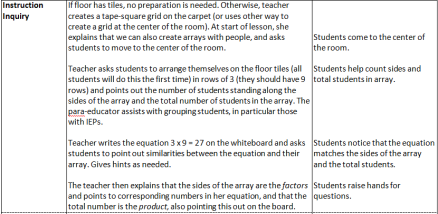P1 – Practice intentional inquiry and planning for instruction. This is an important HOPE principle to me, because it involves personalizing a curriculum that is based in standards to each student, and finding what works best for your class. In particular, it means manipulating tasks so that students are interested, engaged, and working in a way that helps them to be their best. One method for personalizing a potentially boring math lesson to make it more engaging is to get the students out of their seats and moving around the floor. Figure 1 shows an example of a lesson plan I wrote for EDU 6142, Learners in Context, that demonstrates this, turning a Common Core standard on multiplication equations and arrays into a movement activity.According to Medina (2008), “brain-activation studies show that children and adolescents who are fit allocate more cognitive resources to a task and do so for longer periods of time.” They also perform better at cognitive tasks when engaged in activities that increased the flow of oxygen to their brain (Medina, 2008). This means that if teachers were to incorporate more movement activities into everyday lessons (or even, as Medina suggests, set up treadmills and stationary bikes at desks) then in general, students would be more likely to pay attention and have higher self-esteem, and less likely to be disruptive, feel depression or anxiety (Medina, 2008). In Figure 1, the lesson has students moving about the room to create arrays with their bodies, and asks them to count the factors and products together as a class. It also allows for extra students in the group to have a responsibility. This can be modified to include students who can’t or won’t participate, or don’t do well packed into a large group of busy students. Rather than be a part of the array, these students can help by organizing others, counting members of the array, and writing equations on the board. This lesson plan allows me to take into account the individual needs of students while at the same time incorporating an activity that will engage most students in a way that will help them remember the lesson. In the future, more specific planning for students in my class will be needed as I gather information about their learning styles.
Medina, J. (2014). Brain rules: 12 principles for surviving and thriving at work, home, and school. Seattle, WA: Pear Press.
